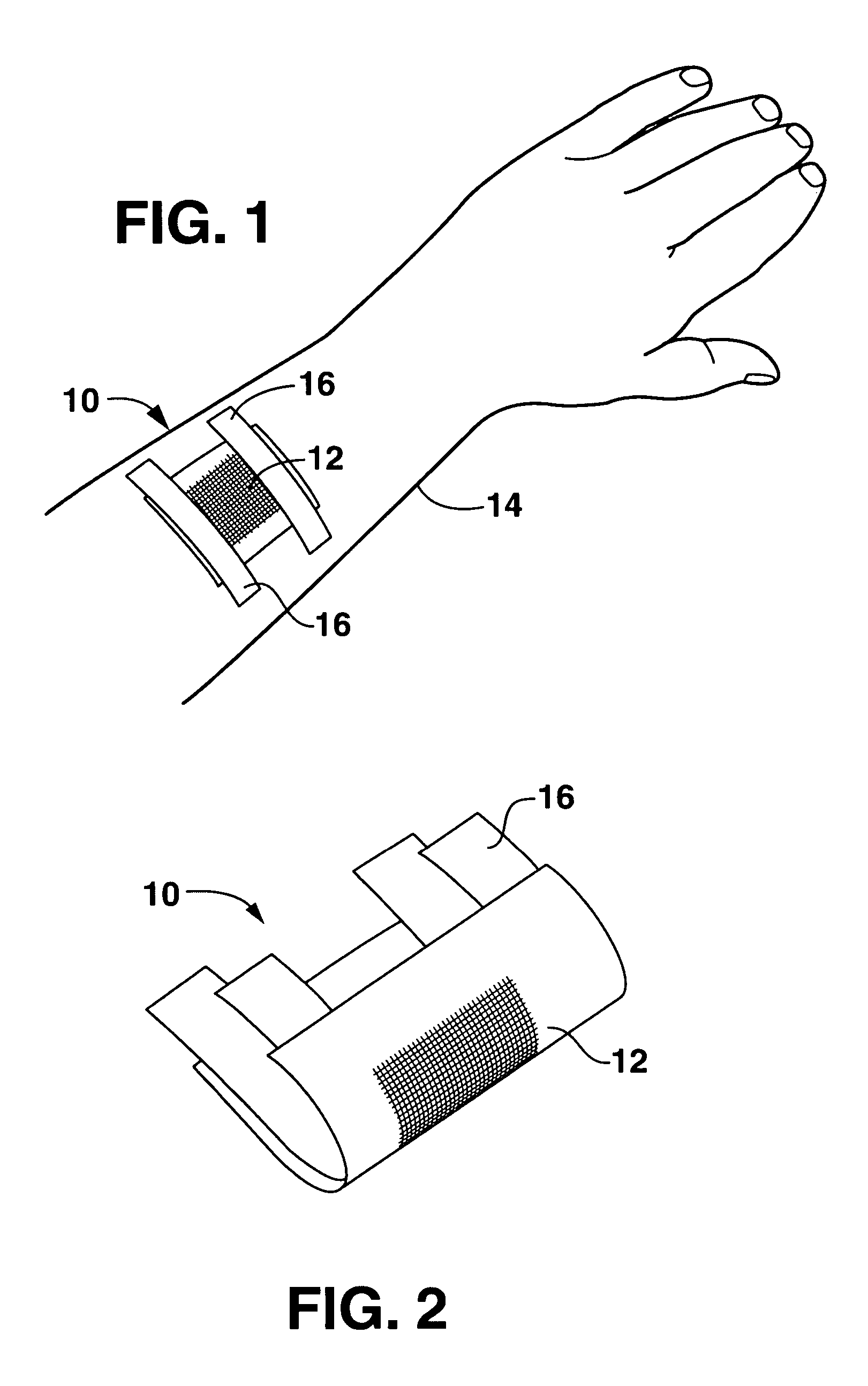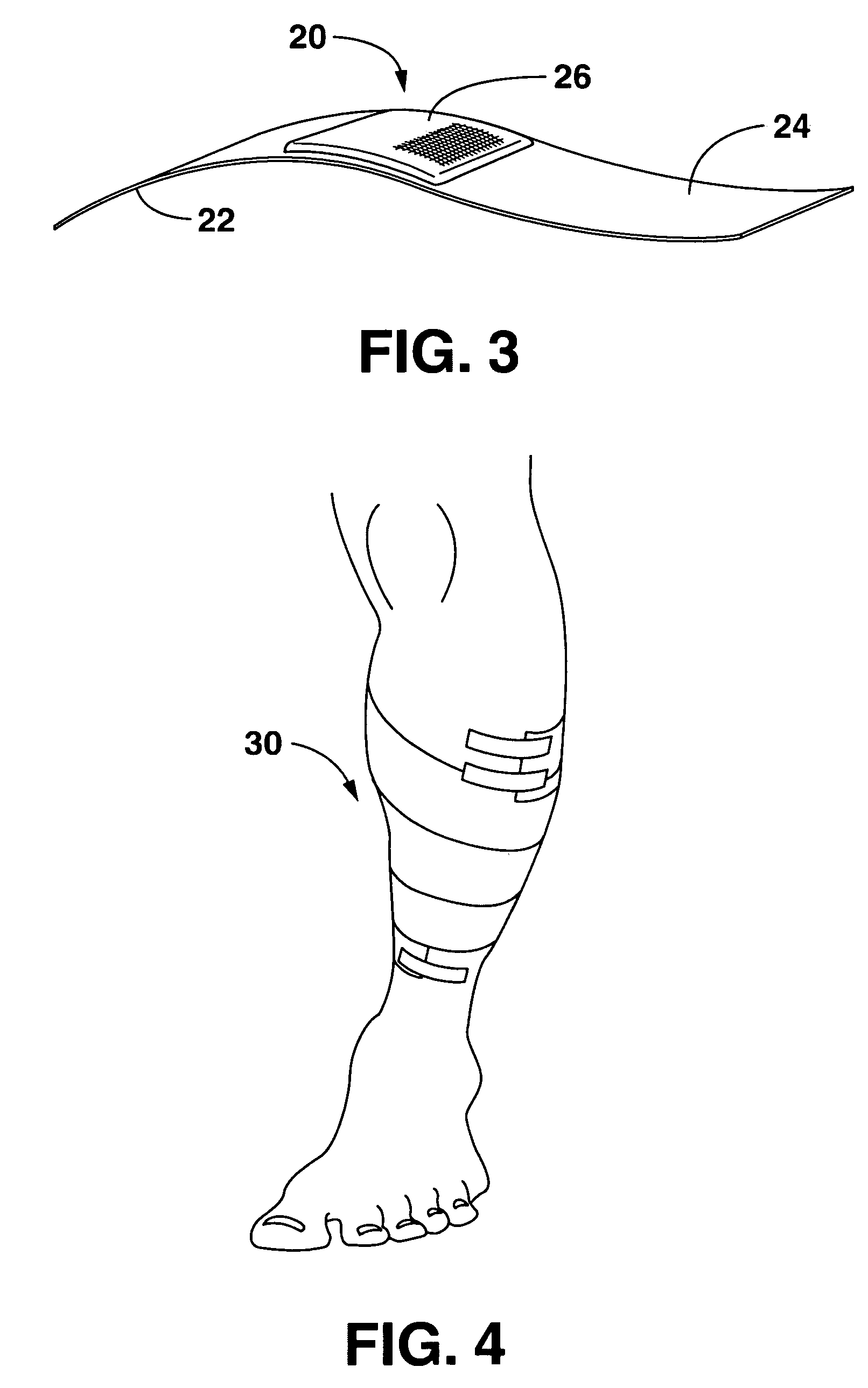Wound or surgical dressing
a wound dressing and surgical technology, applied in the field of wound or surgical dressing, can solve the problems of allergic reactions of individuals, achieve the effects of reducing bacterial growth, improving the effect of bacteriostatic composition, and improving bonding to the substra
- Summary
- Abstract
- Description
- Claims
- Application Information
AI Technical Summary
Benefits of technology
Problems solved by technology
Method used
Image
Examples
example 1
[0076]In order to determine the effect against bacteria of an aluminum chlorohydrate treated material, an assay was designed that measured the growth of E. coli in material treated with the aluminum chlorohydrate. The assay procedure is as follows.
[0077]An E. coli solution in PBS (100 μL of 104 cells / mL) was added to treated and untreated VIVA® paper towels available commercially from the Kimberly-Clark Corporation and wire textured coform laminates (WTCL). The materials were then placed in 4 mL of media containing ampicillin. The cultures were shaken overnight at 37° C. to see if the materials would inhibit cell growth.
[0078]The following day the absorbance was measured at 590 nm and 650 nm to estimate cell growth.
[0079]
MaterialA@590 nmA@650 nmMedia0.035, 0.0340.064, 0.041Positive control0.361, 0.3320.386, 0.364VIVA ® Paper Towel0.039, 0.0390.089, 0.084VIVA ® Paper Towel + E. coli0.207, 0.2090.254, 0.251VIVA ® Paper Towel Al0.036, 0.0360.074, 0.044VIVA ® Paper Towel Al + E. coli0.0...
example 2
[0081]The above experiment was repeated as described by adding 100 μL of 104 cells / mL E. coli solution or PBS onto treated and untreated materials. The materials were then placed in 3 mL of media containing ampicillin. The cultures were shaken overnight at 37° C. to see if the materials would inhibit cell growth.
[0082]The materials tested included VIVA® paper towels and uncreped through-air dried (UCTAD) paper towels.
[0083]The absorbance at 590 nm was measured, and aliquots were removed for serial dilutions for plating for most of the samples.
[0084]
ColonyMaterialMass (mg)A 590 nmA 590 nmCounts*Cells / mLPBS in media0.042, 0.042(negative control)100 μL of 104 cells / mL0.564, 0.616VIVA ® Paper Towel134, 1150.210, 0.2360.234, 0.24277, 98, 164, 1621.3 × 109VIVA ® Paper Towel 0.5%107, 1050.143, 0.1380.089, 0.0841644, 1548, 1040, 11601.3 × 108VIVA ® Paper Towel 1%113, 1230.081, 0.0710.073, 0.075693, 713, 1110, 10759.0 × 107VIVA ® Paper Towel 1%116, 1070.065, 0.0740.073, 0.083233, 251, 478, 5...
example 3
[0086]In order to test the ability of a material treated with the aluminum chlorohydrate to attract anions, experiments were designed to determine how a negatively charged liquid will interact with both treated and untreated materials.
[0087]A piece of gauze was treated with aluminum chlorohydrate by dipping the material into a 1 wt % solution of the compound, squeezing out the excess liquid, and then drying the gauze at about 80° C. for 20 minutes. The gauze was then rinsed with deionized water, and the excess liquid was squeezed out. The gauze was dried at 80° C. for 20 minutes.
[0088]A piece of untreated gauze and a piece of treated gauze were tested by forcing a 0.1 wt % solution of FD&C Blue #1 into each piece of material, using a pipette. Five microliters of the anionic dye solution was put into each piece of gauze in multiple places. Each piece of gauze was rinsed copiously with water.
[0089]The dye remained in the treated gauze, and more specifically in the areas that the dye w...
PUM
| Property | Measurement | Unit |
|---|---|---|
| contact angle | aaaaa | aaaaa |
| contact angle | aaaaa | aaaaa |
| contact angle | aaaaa | aaaaa |
Abstract
Description
Claims
Application Information
 Login to View More
Login to View More - R&D
- Intellectual Property
- Life Sciences
- Materials
- Tech Scout
- Unparalleled Data Quality
- Higher Quality Content
- 60% Fewer Hallucinations
Browse by: Latest US Patents, China's latest patents, Technical Efficacy Thesaurus, Application Domain, Technology Topic, Popular Technical Reports.
© 2025 PatSnap. All rights reserved.Legal|Privacy policy|Modern Slavery Act Transparency Statement|Sitemap|About US| Contact US: help@patsnap.com


